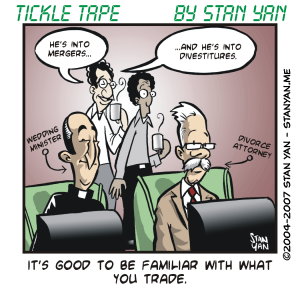Many amateur, online investors can’t wait to make trades and a lot of them. Most of the trades are unprofitable, though, generating commissions for the brokerage and providing sources of profits for active, seasoned traders. If you are just starting out in this business, it’s wise to avoid jumping in too soon. It’s useful to study the markets, get the right trading platform, computers, and other equipment, accumulate a solid knowledge base, and save up enough capital to give it your best shot. That said, there comes a point where you must move from the preparation and planning stage to the active trading stage.
The seasoned trader doesn’t trade all day, every day. Market conditions change and it is wise to stand aside until your trading methods match market conditions. At other times you may be feeling off, and it may be better to watch the market than trade it.
Trading is a matter of moving from studying and observing to actively participating. For the novice trader, or the trader in a severe slump, jumping in can be scary. Trading outcomes aren’t a certainty. If we knew we could just put on a trade and take home a sure profit, we couldn’t wait to put on trade after trade. (Indeed, that’s why most amateur, online investors overtrade. They are unrealistically optimistic and put on a trade even if it has a poor chance of making a profit.)
Getting actively involved in trading requires resolute implementation of a combination of cognitive and behavioral strategies. On the cognitive side, you must examine your thinking strategies and change them. It’s just like jumping into a cold swimming pool. Why don’t you just take the plunge? It’s because you think you’ll get hurt. If you are hesitant about putting on trades, it’s because you are afraid. You’re afraid to lose, to be wrong, and to face your limitations.
If you arm yourself with thinking strategies, however, you’ll be able to muster enough gumption to take the plunge. It’s time to follow the sage advice of seasoned traders: Expect to lose. Winning traders take losses in stride and that’s what you are going to have to do. Look at your assumptions and change the internal dialog you have while getting ready to trade. You may think, “If I lose, it will mean I can’t trade.” But what you should think is, “A loss is just feedback. It doesn’t mean anything about me. I can still learn how to trade. I’m not going to set my expectations unrealistically high.
I’m just going to see what happens, and no matter what happens, I’m not going to draw the conclusion that I’ll never become a seasoned trader. Even if I blow out my account, it will be a learning experience. It will be money I spent on tuition to learn how to master the game.” Once you are armed with these cognitive strategies, you can face potential losses more easily. Some traders have even found it helpful to write down an upbeat passage, like the one above, and read it over and over before a trade and after a loss to restore a courageous, optimistic outlook.
On the behavioral side of things, it’s vital for survival to control risk. Make small trades and wait for high probability setups. There’s no such thing as a guaranteed trade. Unless you manage risk, you’ll surely blow out (especially if you are a novice trader), so you must risk relatively little on a single trade or set of trades. That said, you must bite your lip and take the plunge.
If you are afraid to take the plunge, you might consider easing into it. Start out making extremely small practice trades. The trades can be so small that the commissions on them are more than any possible profit you can make. It’s worth the costs. It will get your feet wet. It will take the mystery out of the whole process. People have a natural inclination to believe that a feared or dreaded event is more hurtful than it actually is. We tend to exaggerate the potential harm.
Once we jump into the activity, however, we see that it isn’t so bad. Our worst fears are usually never realized. Once you make a series of small trades successfully, you can increase your position size until you reach a position size consistent with your account size. The trick is to take gradual steps. It’s like building up physical stamina. Don’t try to do too much all at once. Work up to it.
Taking the plunge into trading actively can be scary, but we often think it’s easier to avoid fears than face them head on. If you examine the assumptions underlying your fear of losses, and then make actual trades to break out of your imposed psychological shell, you can master the markets and become a seasoned, winning trader.


